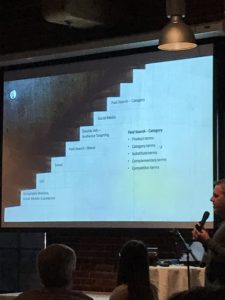This month’s SEMpdx event was all about prioritizing, building, and measuring your digital campaigns with John McPhee and Ryan Campbell of OregonLive. Chock full of both basic review and advanced tips and tricks, our team walked away from the event with our heads brimming with knowledge. In this post, we will discuss our three biggest takeaways from the evening.
1. Set Your Foundation

It feels unnecessary to remind yourself to set a firm foundation. However, this is often skipped in an effort to speed up results for digital campaigns. John shared this graphic (right) derived from a Google employee’s article with us and walked through each step. He noted that we must take things one step at a time and start with a solid foundation. John also referred to the first three steps as the “low-hanging fruit,” suggesting this is where all digital campaigns should start.
2. Track, But Not Everything
Once you have your foundation set, you’re ready to start measuring (and then updating and perfecting) your campaigns. This is where Ryan jumped in. His first piece of advice was to use Google Analytics to track goals and conversions. But which goals and conversions should you track? Ryan said to analyze the overarching goals of the campaign, then extract trackable micro-conversions from there. A micro-conversion could be a click, download, specific page view, and other measurable actions that assist in a conversion. This way, you can track each step in the conversion process and see where users are ending their journey, what steps you should take next, and overall ways to enhance your campaign.
3. Forget Demographics, Think Behavior
A crucial piece of any campaign is audience targeting. Traditionally, we use demographic attributes such as age, sex, location and occupation to target our ads. Ryan questioned this methodology, pointing out that we have access to user behaviors, such as previous Google searches and/or searches on your website, links they’ve clicked related to keywords you’re focused on, and what types of articles and resources they’ve shared on their social media channels. If a user is searching for “marathons” on Google and clicked a link titled “marathon training schedule,” you might want to target said user if you’re selling running shoes. Using traditional demographics alone makes it exceedingly difficult to specify such a detailed target audience.
Now What?
John and Ryan covered several more topics throughout the event, but even just those takeaways might be overwhelming to those who aren’t digital marketing nerds. Lucky for you, we’re a whole team of digital marketing nerds. If you’re concerned about how to move forward, give us a call at (800) 893-2590 and we’ll explain how our services can help. Or, if you want more weekly industry insights, follow LegalRev on Twitter and like us on Facebook!





